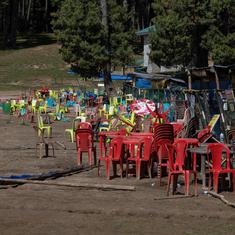The films of Alejandro Jodorowsky single-handedly challenge the rationalistic, intellectualised dominance of European arthouse cinema. Along with Sergei Paradjanov, Jodorowsky has created a unique blend of theatre, music and visual art to produce a mystical form that is essentially cinematic.
His new film Endless Poetry will be screened on August 12 at the Locarno Film Festival, where he will also be awarded with a Pardod’Onore, Locarno’s honorary prize, for his career.
Jodorowsky came to the fore with his second film El Topo (1970), which was became the first “midnight cult movie”. Jodorowksy’s approach was to raise the consciousness of himself and his crew while making the film, and the audience whilst watching it.
The Chilean playwright, self-described “psychomagician”, filmmaker and mimic considers himself to be the “biggest Surrealist”, as he declared to Andre Breton, the founder of the art movement. Surrealism uses imagery to address the subconscious and simultaneously shock the audience with its affect on their nerves. Jodorowskiy also shows a streak of Surrealism’s precursor, Dadaism, which used carefully constructed nonsense to subvert Western critical theory and art history and create a “dandyistic” art form that caricatures audience expectations.
During the production of his third film The Holy Mountain (1973), Jodorowsky isolated his actors in his house and subjected them to mystical training. He ensured that they got only four hours of sleep and had no access to drugs and hired a guru for imparting meditation techniques to raise consciousness.
Hiring what he would call his “spiritual warriors” – French graphic artist Moebius, the Swiss designer H R Giger and the screenwriter and special effects expert Dan O’Bannon – Jodorowsky attempted to produce an iconoclastic tour de force version of Frank Herbert’s 1965 novel Dune. The failure of the project was largely due to Jodorowsky’s eccentric behavior with the producers and his famously impractical approach to money, which he claimed he wanted to lose after the production.
Since what is considered to be his best work, Santa Sangre (1989), Jodorowski’s cinema has combined an obviously Surrealist visual technique with a vital performativity, not very unlike that of Federico Fellini’s cinema.
His films use the actor’s performances and lushly shot frames with functional props (a chair, a hat, a comb). What we are seeing in his films are photographed plays with props and landscapes that provide a suspension of disbelief to the stylised performances. These props and landscapes are merged with genre codes and mystical references, providing a unique stylisation that is purely cinematic. This approach, combined with a generous dose of Dadaist absurdism and genre-bending codes, has given the cult director’s work a new lease of life since the late 1980s.
Santa Sangre for Jodorowsky has become a self-referential textbook, a bit like Yasujiro Ozu’s realisation of his “pillow shot” technique in which he repetitively shoots portions of the interior and exterior between scenes. Very often such realisations, through reflections during the making of the film, are used by the creator for the rest of the works in their career.
A form of theatricality with expressionist lighting, absurdist actions performed by characters and a sort of continuity in this illogical progression, characterise Jodorowsky’s later works. This illogical progression suggests a story in the absurdity of the visuals that has nothing to do with the utterances of their characters. The lack of objectivity of the proceedings suggests a postured staging of events. This staging in turn, leads back to the actors’ performativity.
Jodorowsky’s most recent projects include the autobiographical Dance of Reality and its follow-up, Endless Poetry, which was premiered at the 2016 Cannes Film Festival. The 86-year-old director masterfully indulges in his developed “style” to show himself trapped in the performativity of his own life and the act of making his film. Although Endless Poetry has been critiqued for its controversial homophobic subtext, it lays forward a very simple thesis – cinema is literature transformed into poetry and cut in various ways to produce resonance through the use of differential sequencing and repetition in approach. Jodorowsky cultists across the world are looking forward to watching the film and the next installation of what seems to be an autobiographical trilogy.











